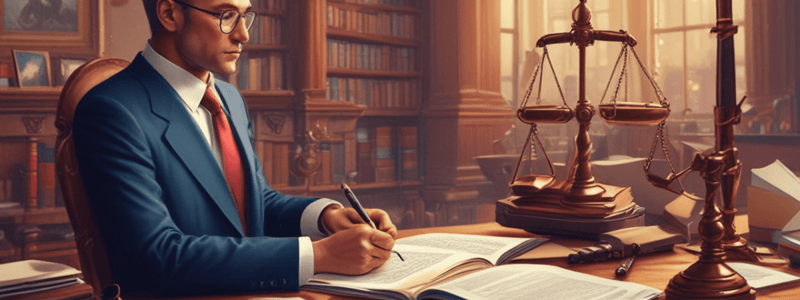Podcast
Questions and Answers
Which element is necessary to establish the tort of injurious falsehood?
Which element is necessary to establish the tort of injurious falsehood?
- Notification of intent
- Proof of truthfulness (correct)
- Public announcement
- Severity of the statement
In the context of injurious falsehood, what does 'knowledge of falsity' refer to?
In the context of injurious falsehood, what does 'knowledge of falsity' refer to?
- Public acceptance of the false statement
- Time elapsed since the false statement
- Location where the statement was made
- Speaker's awareness of the falsity of the statement (correct)
How does injurious falsehood differ from defamation?
How does injurious falsehood differ from defamation?
- Injurious falsehood is not limited to verbal communication (correct)
- Injurious falsehood always involves libel
- Defamation requires proof of knowledge of falsity
- Defamation causes harm to physical health
What type of harm must be proven in injurious falsehood cases?
What type of harm must be proven in injurious falsehood cases?
What sets injurious falsehood apart from truthful statements?
What sets injurious falsehood apart from truthful statements?
Which legal case demonstrates an instance of injurious falsehood?
Which legal case demonstrates an instance of injurious falsehood?
What was the primary issue faced by Mrs. B in the given scenario?
What was the primary issue faced by Mrs. B in the given scenario?
Which of the following is NOT a valid defense against injurious falsehood?
Which of the following is NOT a valid defense against injurious falsehood?
Which of the following statements best describes the concept of 'privilege' as a defense against injurious falsehood?
Which of the following statements best describes the concept of 'privilege' as a defense against injurious falsehood?
What is the primary consequence of injurious falsehoods?
What is the primary consequence of injurious falsehoods?
What is the key factor that determines whether a statement is considered defamatory or not?
What is the key factor that determines whether a statement is considered defamatory or not?
Flashcards are hidden until you start studying
Study Notes
Injurious Falsehoods
Injurious falsehood is a common law tort that arises when one person makes a statement that they know is false and causes injury to another's reputation. This type of defamation involves spreading intentionally damaging information that can harm someone's personal or professional standing. It does not necessarily have to involve slander or libel; any communication method, including verbal and written means, can be used to propagate injurious falsehoods.
Elements of Injurious Falsehood
There are three essential elements required to establish the tort of injurious falsehood:
-
Statement must be false: The first element requires proof that the statement made is indeed untrue. If the statement was true, it would not be considered defamatory.
-
Knowledge of falsity: The second element required is evidence showing the speaker knew their statement was false or that they had reason to believe it was false. Without this knowledge of falsity, the accusation cannot be proven.
-
Damage to reputation: The third element is proving that the false statement caused harm to the victim's reputation. Reputational damage may occur if the false information influences others to view the person unfavorably, causing them social, economic, or other types of harm.
Example of Injurious Falsehood
A classic example of injurious falsehood can be seen in the case of Brown v. Stockdale. Here, the defendant, Mr. A., stated that his neighbor, Mrs. B., had been charged with theft from her employer. Although these allegations were false, they were still broadcasted through public channels, resulting in widespread damage to Mrs. B.'s reputation.
Defenses against Injurious Falsehood
There are several defenses available to a person accused of injurious falsehood:
-
Truth: If the statement made is true, even if it is damaging, it is not considered defamatory.
-
Honest Opinion: If the statement made is an expression of a person's genuine and genuinely held opinion, it is less likely to be considered defamatory.
-
Privilege: Certain circumstances may provide legal protection, such as statements made in court proceedings or statements made in good faith to prevent harm to others.
Injurious falsehoods can cause significant damage to a person's reputation and personal or professional life. It is essential to be aware of the elements required to prove this tort and the defenses available to those accused.
Studying That Suits You
Use AI to generate personalized quizzes and flashcards to suit your learning preferences.




